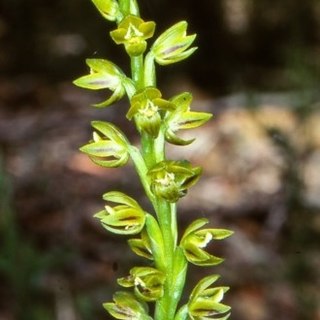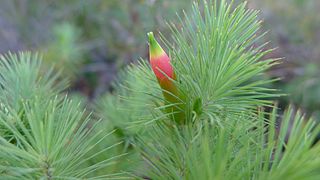
Myoporum parvifolium, commonly known as creeping boobialla, creeping myoporum, dwarf native myrtle or small leaved myoporum is a plant in the figwort family, Scrophulariaceae. It is a low, spreading shrub with long, trailing stems and white, star-shaped flowers and is endemic to southern Australia including Flinders Island.

Dampiera stricta commonly known as blue dampiera, is a flowering plant in the family Goodeniaceae. It is a small sub-shrub with variable leaves and mostly blue, mauve or purple flowers.

Prostanthera rhombea, commonly known as sparkling mint-bush, is a plant in the family Lamiaceae and is endemic to disjunct areas of south-eastern Australia. It is an openly-branched shrub with strongly aromatic branches, circular to heart-shaped leaves and mauve or bluish flowers.

Prostanthera denticulata, commonly known as rough mint-bush, is a species of flowering plant in the family Lamiaceae and is endemic to coastal New South Wales. It is a straggling to almost prostrate, aromatic shrub with narrow egg-shaped leaves and purple to mauve flowers arranged in leaf axils or on the ends of branchlets.

Prostanthera saxicola is a species of flowering plant in the family Lamiaceae and is endemic to eastern Australia. It is a shrub with linear to elliptic leaves and white to mauve flowers arranged in leaf axils.

Leucopogon affinis, commonly known as lance beard-heath and formerly known as Leucopogon lanceolatus is a flowering plant in the heath family Ericaceae and is endemic to eastern Australia, including Tasmania and South Australia. It is an erect shrub with spikes of small white flowers in early spring, followed by orange-red fruit.
Prasophyllum australe, commonly known as the southern leek orchid or austral leek orchid, is a species of orchid and is endemic to south-eastern Australia. It has a single tubular, green leaf and up to fifty scented, greenish-brown flowers with red stripes.

Prasophyllum flavum, commonly known as the yellow leek orchid, is a species of orchid endemic to eastern Australia. It has a single tubular, green leaf with only a short free section and up to fifty scented, yellowish-green flowers.
Genoplesium baueri, commonly known as the brittle midge orchid, is a small terrestrial orchid which is endemic to New South Wales. It has a single thin leaf and up to nine yellowish green to reddish brown flowers. It is mostly only found in coastal and near-coastal heath and woodland between Port Stephens and Ulladulla.
Thelymitra fuscolutea, commonly called the chestnut sun orchid, is a species of orchid in the family Orchidaceae and is endemic to the south-west of Western Australia. It has a single erect, flat, leathery leaf and up to fifteen or more yellowish green flowers with reddish brown streaks and blotches. The column has broad, deeply fringed cream or whitish wings.

Pimelea curviflora, also known as curved rice-flower is a shrub in the family Thymelaeaceae and is endemic to Australia. It is a small, hairy shrub with greenish-yellow or red tubular flowers.

Stenanthera pinifolia, commonly known as pine heath, is a species of shrub that is endemic to south-eastern Australia. It has narrow, linear leaves, yellow or red tubular flowers and a small edible berry.

Chloanthes stoechadis is a species of flowering plant in the family Lamiaceae. It is a small under shrub with wrinkled leaves and yellowish green flowers.

Hibbertia acicularis, commonly known as prickly guinea-flower, is a species of flowering plant in the family Dilleniaceae and is endemic to eastern Australia. It is an erect or prostrate shrub with linear to lance-shaped leaves and yellow flowers arranged singly in leaf axils with the six to eight stamens joined at the base, in a single cluster.
Goodenia pumilio is a species of flowering plant in the family Goodeniaceae and is native to northern Australia and New Guinea. It is a prostrate, stolon-forming herb with egg-shaped to lance-shaped leaves in rosettes, and racemes of small, dark reddish-purple flowers.

Lechenaultia expansa is a species of flowering plant in the family Goodeniaceae and is endemic to the south-west of Western Australia. It is a prostrate to erect subshrub with wand-like branches, crowded, narrow, fleshy leaves and pale purple-blue, tube-shaped flowers.

Leucopogon appressus is a species of flowering plant in the heath family Ericaceae and is endemic to south-eastern New South Wales. It is a small, spreading to erect shrub with wiry stems, lance-shaped or narrowly egg-shaped to elliptic leaves and small white flowers.

Leucopogon australis, commonly known as spiked beard-heath, is a species of flowering plant in the heath family Ericaceae and is endemic to southern Australia. It is an erect, aromatic shrub with narrowly egg-shaped to narrowly elliptic leaves, and white flowers arranged in spikes near the ends of branchlets.
Epacris exserta , commonly known as South Esk heath, is a species of flowering plant in the heath family, Ericaceae and is endemic to Tasmania. It is an erect shrub with narrowly lance-shaped to elliptic leaves and tube-shaped, white flowers clustered near the ends of the branches.

Leucopogon collinus, commonly known as fringed beard-heath, is a species of flowering plant in the heath family Ericaceae and is endemic to the south-eastern Australia. It is a slender, erect or spreading shrub with narrowly lance-shaped leaves, and white, tube-shaped, bearded flowers.















